In the Northwest part of Chinese Fujian Province, there is a rocky mountain called as Wuyi. In English, it is also called as Bohea, which is from local Fujian ancient dialect pronunciation of Wu-yi.
Scenery of Wuyi
Wuyi has been a famous tea producing place in Chinese history for long time. The rocky growing surrounding of Wuyi endows the Wuyi tea with talented outstanding quality. As Tea Saint Luyu commented in the Classic of Tea ”upper level quality tea grow in rocks, middle level from little stone and sandy soil and lower level quality from yellow earth’. 上者生烂石, 中者生砾壤,下者生黄土.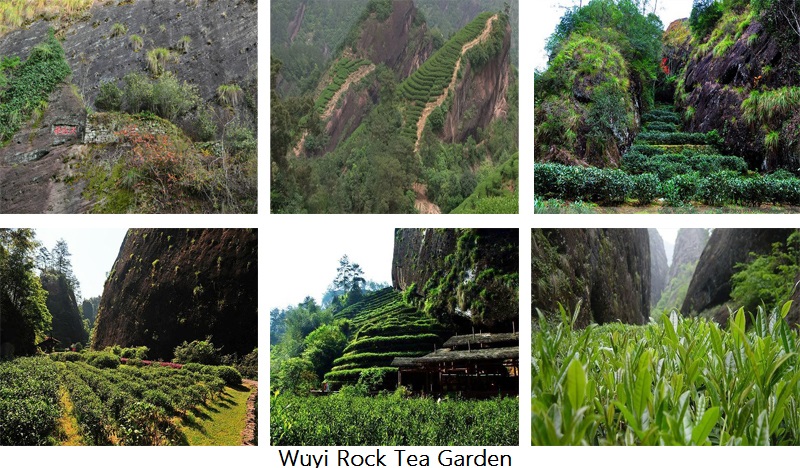
The earliest Wuyi tea appeared in Chinese documentary in Yuanhe Era (806-820 AD) of Tang Dynasty under the name Wan Gan Hou 晚甘侯.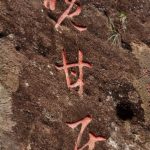
One imperial official SUN Qiao of Tang Dynasty wrote to a senior minister mentioning he sent some Wuyi tea to him and also told him this tea was very good quality and precious.
晚甘侯十五人, 谴侍斋阁。此徒皆乘雷而摘,拜水而和。盖建阳丹山碧水之乡,月涧云龛之品,慎勿贱用之!
This is a very interesting letter. SUN Qiao was using personification metaphor to call the Wuyi tea as Wan Gan Hou (Sir Sweet Aftertaste), and told the senior minister that the tea was made in Wuyi Shan with outstanding material and exquisite processing. It was very precious and please do not look down upon them.
In Song Dynasty (960-1279AD), Wuyi tea become more and more famous. The imperial palace requested tribute tea from North Fujian State (建州), to which Wuyi Region is subject. The regions in North Fujian State (建州) would compete their tea at first before being selected as tribute tea material. This kind of competing activities lasted for around one century which greatly enhanced the development of Wuyi Tea. In Song dynasty, the tribute tea was made into Dragon and Phoenix Tea Cake.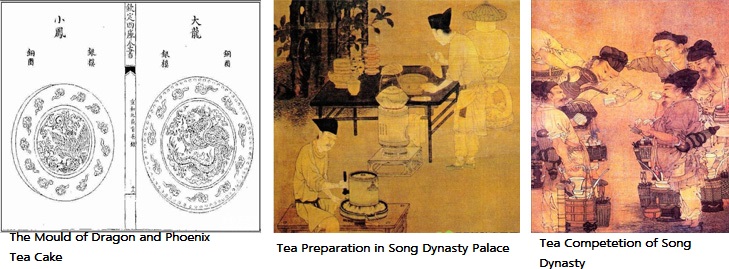
Tea history of Wuyi
In Yuan Dynasty (1271-1368AD), the Mongolian Emperors also highly appreciated the Wuyi tea. They ordered to build up imperial Tea Garden at the bank of Stream of Nine Winding 九曲溪. And appointed special official to supervise the Imperial Tea Garden.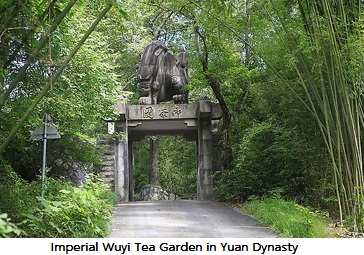
In Ming Dynasty (1368-1644AD), the founder also as the first emperor of this dynasty Zhu Yuan Zhang was born as a farmer. He could not appreciate tea very well. After he took power he ordered to stop tribute of Dragon and Phoenix Cake Tea, and later onwards, the tea need just to be made into loose form green tea. Wuyi tea was suffering a huge depression due to the new imperial order. Throughout the Ming Dynasty, Fujian tea including Wuyi tea was not appreciated. However the Wuyi tea was still developing quietly. Finally revolutionary change happened. The Wuyi farmers had learned the processing of Song Luo Green Tea (松萝茶) from Anhui in Ming Dynasty. Later in the end of Ming Dynasty, Black Tea (Lapsang Suchong) and Oolong Tea (nowadays Wuyi Rock Tea) was invented in Wuyi from the mutation processing of Song Luo. It is still not clear Black Tea or Oolong Tea was earlier invention. But it seems they are very close in birth time. Both of them appeared in the documentary of end Ming Dynasty (1600s).
Wuyi people were very creative in changing the processing of Song Luo Tea since the old Wuyi tea was already not popular at that times in China domestic. It happened the newly born Black Tea and Oolong Tea was soon very well accepted by Western Countries. It should be the Dutch who shipped the new Wuyi Tea from the Ocean Silk Road to Europe. Tea drinking started in the European palaces, later it soon spread to each class of people. 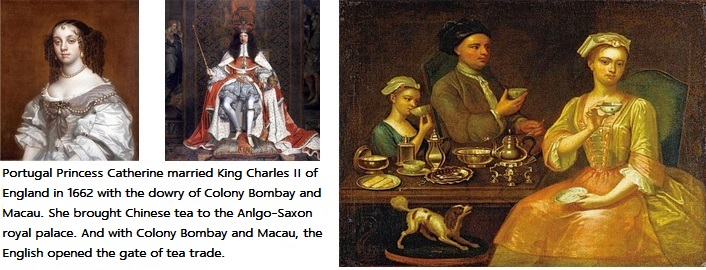
The Europeans were fascinated by the quality of Wuyi tea. Later it formed the tradition of calling Chinese good quality tea as ‘Bohea’ Tea among Europeans. ‘Bo-he-a’ is the Fujian dialect pronunciation of Wu-yi. Generally Wuyi Tea would be booked and sold out immediately once it arrived in the European ports in the early centuries.
The huge demand of Wuyi Tea on the other way round stimulated the development of Wuyi tea. The Wuyi tea farmers kept selecting fine cultivars and improving processings to obtain better quality Wuyi Rock Tea. 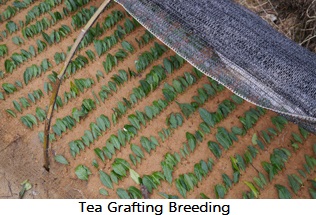
As a result, more and more special types of Wuyi Rock Tea were invented. Up to now, around two hundred cultivar types of Wuyi Rock Tea exist. But most of them are seldom-seen types. There are a few common types of Wuyi Rock Tea. Generally they are Da Hong Pao, Shui Xian, Rou Gui, Tie Luo Han, Shui Jin Gui, Ban Tian Yao, Bai Ji Guan, Qi Lan and Lao Cong Shui Xian.Especially Da Hong Pao, Shui Xian and Rou Gui are commonly-seen types among them.
1 Da Hong Pao (en. Big Red Robe) is the most famous and precious Wuyi Rock Tea. The name of this tea cultivar might come from two stories. The first one is that in the past the tea grown in steep rocks. And the monks in the temple trained monkey to pluck the tea in Spring. When the monkey plucked tea, they will wear red vest. So the tea was named after this, Da Hong Pao (Big Red Robe). The second story is that a few hundred years ago, a student went to the capital to take part in the imperial exam. While he was seriously ill on the half way. The monks in one temple of Wuyi offered accommodation to him. And they used tea plucked from the rocks nearby the temple to cure his illness. The student recovered. And he went on to the capital for the exam. It turned out that he was picked as No.1 by the emperor in the final imperial exam. He was ascended to the imperial official. Later he went back to his hometown. And he was so thankful to the monks and the tea they served him that he took off the red robe on his body to cover the tea tree on the rocks. Later these tea trees were named as Da Hong Pao.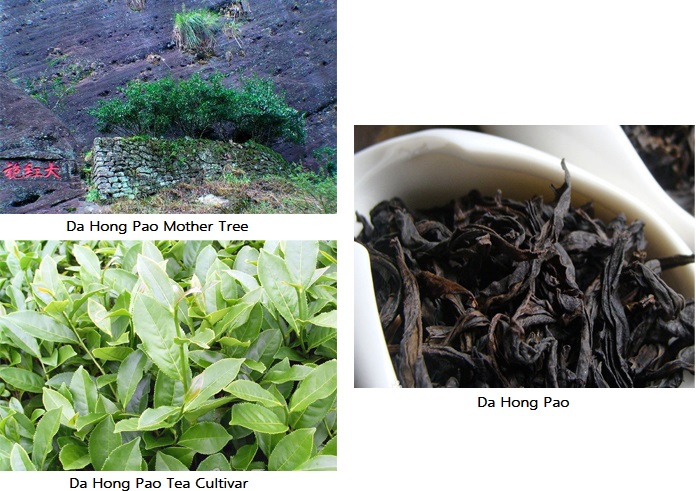
2 Shui Xian is a cultivar introduced from Jianyang County. Jianyang is nearby to Wuyi and used to be the center of Beiyuan Royal Tea Garden in Song Dynasty. This cultivar is believed to be originated from Beiyuan Royal Tea Garden. One story tells that long time ago a poor young farmer in Jianyang went to cut firewood in the forest. While he felt tired and dizzy before a rock cave. So he sit down to take a rest. When he saw a plant with white flower and lovely green leaves. He plucked some leaves to chew in the mouth. Immediately he felt refreshing and energetic. He cut one branch from the plant to carry with him and went on his work. After he arrived home, it happened storm and rain came in the night, The plant branch was buried by the collapsed earth wall and only a short shoot was left outside. While in the morning it germinated soon. And a few days days a plant grown up. The young farmer kept plucking tender leaves from the plant to eat. Later his neighbors found him grow stronger and smart. And they all came to his place to ask for the herb he was using. They asked him where he found this fairy herb. He told them frankly. His neighbors learned from him and bred the plant using the method as the young man. Soon later this cultivar spread up to many places including Wuyi. Because the rock cave where the plant was found was Zhu Xian Dong (祝仙洞) . They named this cultivar as Shui Xian. Shui Xian is the local dialect pronunciation of Zhu-xian. This story might demonstrate the invention of grafting technology of tea breeding in a legendary way.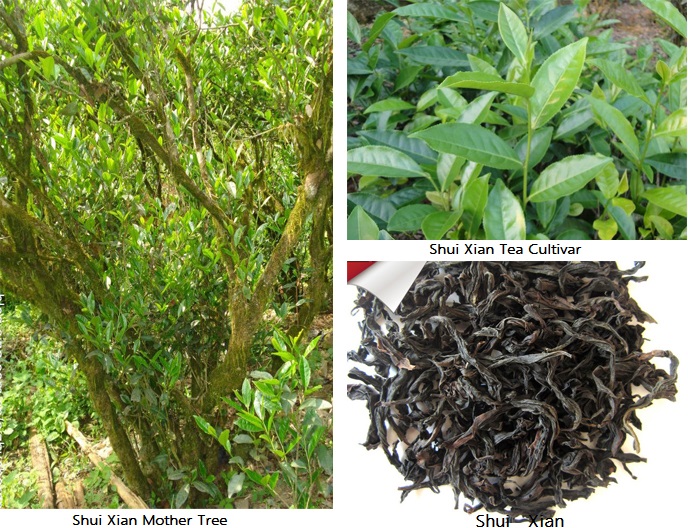
3 Rou Gui is the most fragrant Wuyi Rock Tea. In Wuyi there is a saying, 香不过肉桂 醇不过水仙. It means‘No tea is more fragrant than Rou Gui and No tea is mellower than Shui Xian’. The flavor of Rou Gui is a bit similar to Cinnamon (Rou Gui 肉桂 is the Chinese name of Cinnamon), though obvious difference can be felt if smell carefully. The original place of Rou Gui in Wuyi is Ma Zhen Feng and Hui Yuan.
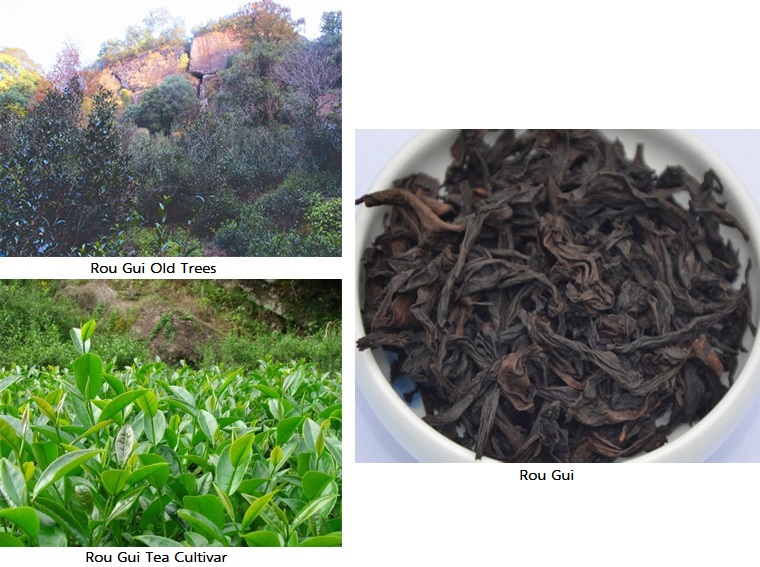
4 Tie Luo Han (Iron Arhat) is one of the rare and precious Wuyi Rock Tea cultivars. The name of Tie Luo Han might come from two resource. The first one is that the tea merchant SHI Da-cheng of South Fujian Hui’An County was running tea business in Wuyi in the middle of 19th century. It happened that in the end of 19th century plague occurred in his hometown Hui’An County for tow times. The countrymen of SHI Da-cheng used his Wuyi Rock Tea to cure the illness. Many of the patients were save by this recipe. Chinese believe that Buddhist arhat will save people when disaster happen. So the named the type of Wuyi Rock Tea from SHI Da-cheng as Tie Luo Han (Iron Arhat).
The other one is a fairy story. There are five hundred arhats in Buddhism. And one of them was in charge of tea. The other day, the tea arhat went to attend a banquet of Western Heaven Queen. And he was drunk. Accidentally he broke his power stick. The broken stick fell down to Wuyi and it penetrated into a big rock. Later the stick germinated and grown up from the rock into a tea tree. Wuyi People named this tea tree Tie Luo Han (Iron Arhat) and widespreadly bred this cultivar. 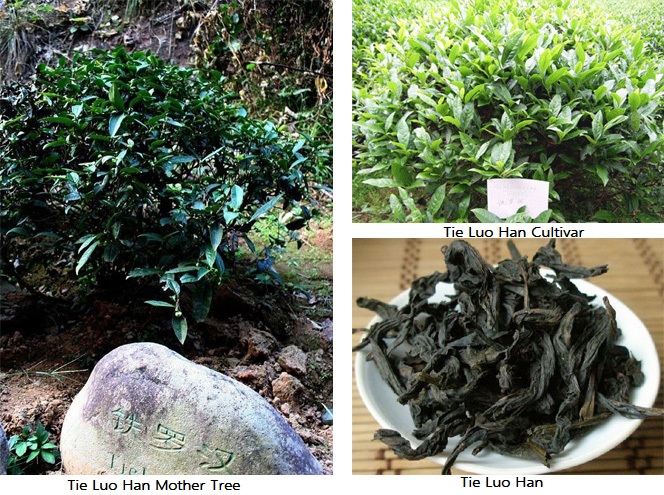
5 Shui Jin Gui (Water Golden Tortoise) The mother tree of Shui Jin Gui (Water Golden Tortoise) grow in the middle of the steep rock of Niu Lan Keng of Wuyi. It has dense green leaf cover and the tender leaves are shiny yellowish green color. In sunny days, look from far away the tea leaves look like golden tortoise shining in the water. This is why it is named as Shui Jin Gui (Water Golden Tortoise). It is one of the rare and precious Wuyi Rock Tea cultivars.
This tea is famous for a lawsuit. In end of Qing Dynasty, the Shui Jin Gui mother tea tree was growing in the rock nearby Tianxin Temple and belong to Tianxin Temple. One day, flood washed away the tea tree to Niu Kan Keng. And the farmers of Niu Lan Keng found this tea tree. They build up a small stone tea garden in Niu Lan Keng to plant this tea tree again. Some time later, the monks of Tianxin Temple came to know the whereabouts of the tea tree. They asked the farmers of Niu Lan Keng to return the tea tree. But the farmers hold that they found the tea tree, not stole the tea tree and they refused to return. So a lawsuit started. Since the appeals of both parties sounded reasonable, the lawsuit were not easy to judge. The lawsuit went on for long time. Finally an imperial grand justice concluded that the tea tree was carried to Niu Lan Keng by flood as natural force. And this is a kind of Heaven Wish (天意). And the Heaven Wish should be respected. So he made a verdict that the ownership of the Shui Jin Gui tea tree belong to the Niu Lan Keng tea farmers. Tianxin Temple cost vast amount of money on the lawsuit for this tea tree, though lost the lawsuit in the final. And because of this lawsuit, people came to know how precious this Shui Jin Gui tea tree was.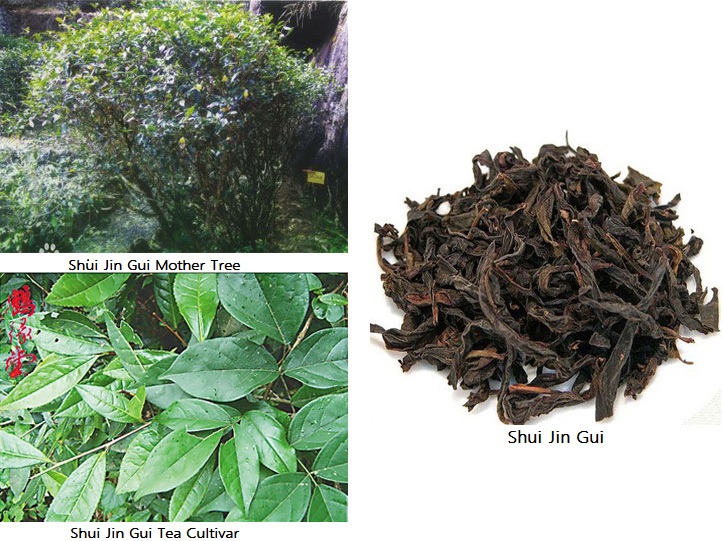
6 Bai Ji Guan (White Cockscomb) is one of the precious and rare Wuyi Rock Tea cultivars.The name of this cultivar comes from the tea tree’s looking. The tender shoots of Bai Ji Guan (White Cockscomb) is bright jade yellowish color. In Spring the tea tree with tender shoots looks like a green cock with a white cockscomb on the top. It’s originated in the Outer Ghost Cave (外鬼洞) of Hui Yuan, Wuyi. The Rock Tea made by this cultivar is brownish yellow color and has a kind of sweet corn flavor. The aftertaste is quiet and lasting.
A story tells that in the past a farmer went to celebrate his father-in-law’s birthday with a cock. When he passed by Hui Yuan, he found a shadowy cave to take a rest and left the cock under a tea tree. Suddenly he heard the cock screech. He went to check and found a snake slip away. The cockscomb was bleeding and it was attacked by the snake. Soon it died. The farmer had to bury the cock under the tea tree and went to his father-in-law’s house with empty hands. When he came back, surprisingly he found the tea tree grow faster. And a few days later, the tea shoots became jade yellowish color and gave off pleasant tea flavor. He tasted the tea shoots and it was very sweet. He made a tea by the shoots. And it was a very fantastic tea. Besides the good quality, it can even be used as medicine to cure cold and inflammation. Later this cultivar spread. And it was named as Bai Ji Guan (White Cockscomb).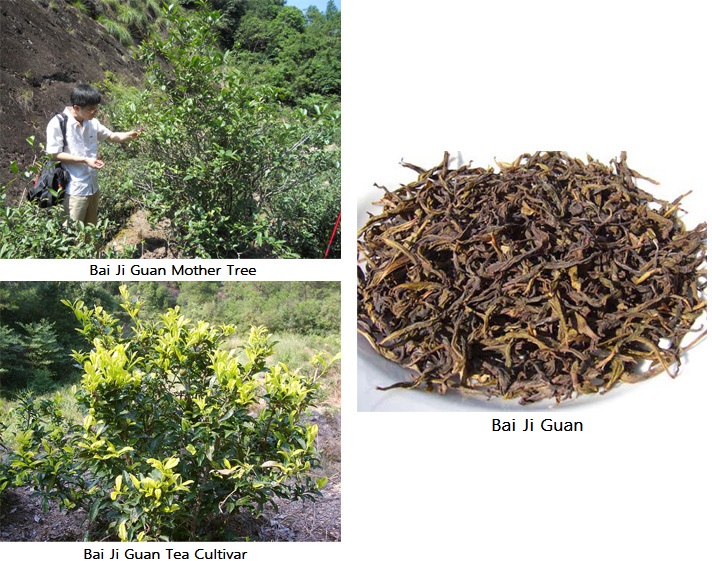
7 Ban Tian Yao is one of the precious and rare Wuyi Rock Tea cultivars. It’s originated from San Hua Feng of Wuyi. The tea is fragrant in flavor and after some time storage it will tun out kind of orange peel flavor. Its taste is strong and mellow.
This cultivar was found hundred years ago in the middle of a high steep rock. A story tells the origin of It. The abbot of Wuyi Tianxin Temple made a dream that a white roller bird carried a shining gemstone with its mouth and was chased by a giant hawk. Later to escape from the hawk, the roller dropped the gemstone in San Hua Feng. After the Abbot woke up, to testify the reality of his dream, the abbot sent a little monk to search the dropped gemstone. The little monk climbed from Suo Yi Feng to the peak of the steep San Hua Feng. He found nothing there. Then he struggled to hang down to the middle of the steep rock by string. There on a small prominent rock he found a jade green tea seed. The little monk carried back the seed carefully and presented to the abbot. The abbot was very happy. Because he found the testimony of his dream. The monk himself planted the tea seed and cared it. After the tea tree grown up, the abbot asked the little monk to move the tea tree to the rock where he found the magic seed. Because the abbot thought it was the fairy roller’s will to plant this magic treasure tea tree there in the middle of the steep rock and they need to follow. The little monk struggled to climb back there and built up a small base for the tea tree on the prominent rock . Then later it was there. They named the tea tree as Ban Tian Yao (It means high in the middle of the sky. And also Yao is the Chinese pronunciation of roller.)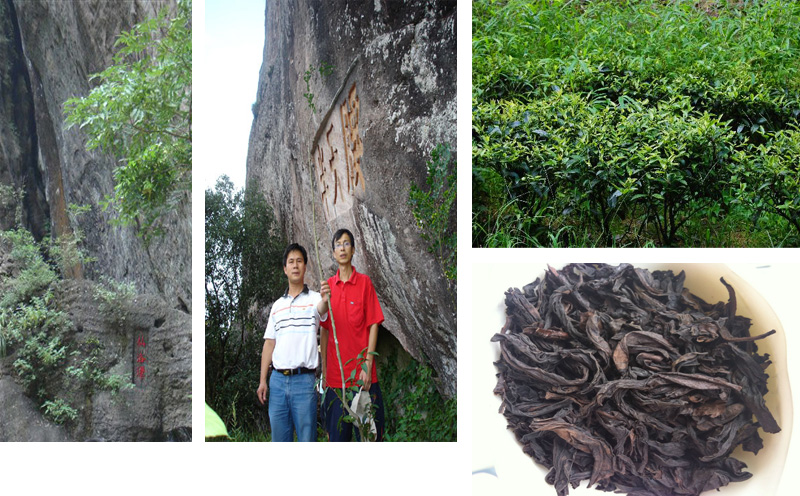
8 Qi Lan is a cultivar originated from Ping He County of South Fujian. It was introduced to plant in Wuyi in 1990s. Due to the outstanding quality of the Rock Tea made by Qi Lan cultivar. Its planting in Wuyi has spread fast in recent years. Qi Lan has become an important Wuyi Rock Tea type. Qi Lan has lasting fragrant flavor. It is the kind of orchid and honey flavor. ‘Lan’ is the Chinese pronunciation of orchid.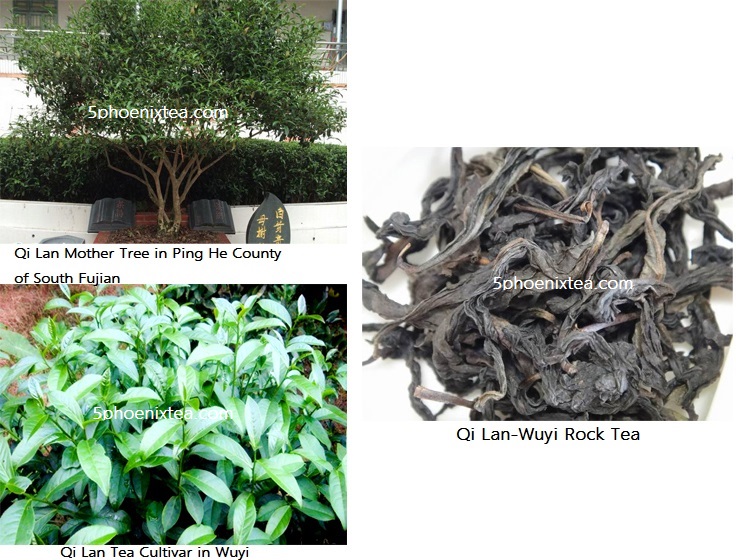
9 Lao Cong Shui Xian is the old tree of Shui Xian cultivar. They are generally of hundred years old and by far they are growing in three areas of Wuyi and nearby area, Huiyuan Keng, Wu San Di and Jianyang Shufang. These old Shui Xian tea trees are the rare and precious heritage of ancient people. And they are the only old trees which are in production for making of Wuyi Rock Tea now. This Wuyi Rock Tea is Lao Cong Shui Xian.Lao Cong Shui Xian grow slower than younger teas, and its tea leaves contains richer minerals and organic contents. The Wuyi Rock Tea made by it has strong fragrant flavor and deep aftertaste. It is one of the best Wuyi Rock Teas.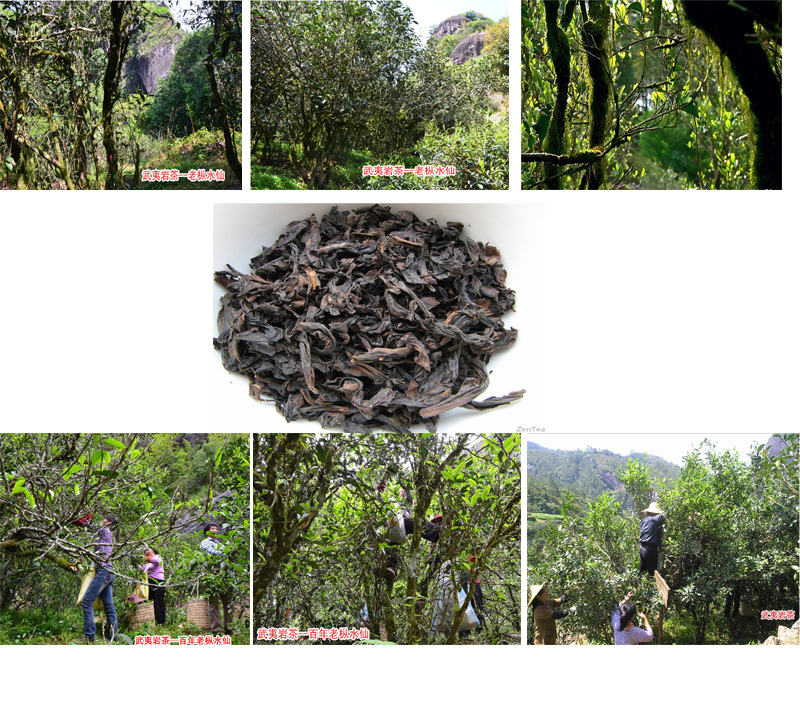
Part 2 Plucking and Processing of Wuyi Rock Tea
Before the introduction of the Plucking and Processing of Wuyi Rock Tea, it is necessary to have a knowledge of the producing place of traditional Wuyi Rock Tea. Nowadays when you go to visit Wuyi, you will arrive in Wuyishan City (武夷山市). Wuyishan City used to be the name Chong’An County (崇安县). And Wuyi was a famous mountain inside Chong’An County. Wuyi is an mountain with the area of around 70km2. And Chong’An County had an area of 2813km2. In 1989, to promote the tourism of Chong’An County, the county name was officially changed to Wuyishan City. While Wuyi Rock Tea is a tea with history of more than three hundred years. So we will know that traditional concept of Wuyi Rock Tea should not be referring to all the tea produced in Wuyishan City (Chong’An County). It should be the tea only produced in Wuyi mountain area. Roughly now it is limited in the area East to Chongyang Xi, South to Nanxing Highway, West to Gaoxing Highway and North to Huangbai Xi.
1 Tea Plucking
The plucking of Wuyi Rock Tea in Spring starts in end of April and last to middle of May. It need to pluck one bud three leaves to four leaves. And neither it can be more tender nor older. Too tender and too old leaves are not suitable for making of Wuyi Rock Tea. Tea Plucking and plucking standard of Wuyi Rock Tea
Tea Plucking and plucking standard of Wuyi Rock Tea
The fresh leaves will be put inside the bamboo load. In the evening, the farmers will transport the load to the factory. In Wuyi, even this transportation is not a simple work. The rocky roads are small and irregular, and the distance is long. The more important is the during the burden, it should be careful to avoid crush of fresh leaves. Broken leaves will effect the following fermentation.
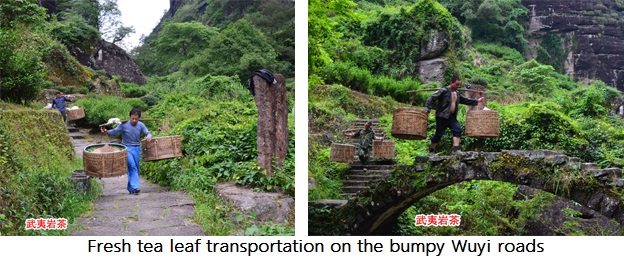
2 Sunlight Withering and Indoor Withering
The fresh leaf will be subject to Sunlight Withering (晒青 Shai Qing). After some time, it will be sent to indoors for Indoor Withering (晾青 Liang Qing). The indoor withering will help cool down the warm leaf heated up by the sunlight, and the water re-distribute well again in the leaf structure. Then it will be sent outside for Sunlight Withering one more time. And then indoor withering again. Generally in Wuyi, they called this 两晒两晾. Which means Sunlight Withering for two times and indoor withering for two times.After withering, the leaves become soft. and the water content will have a loss around 15%.
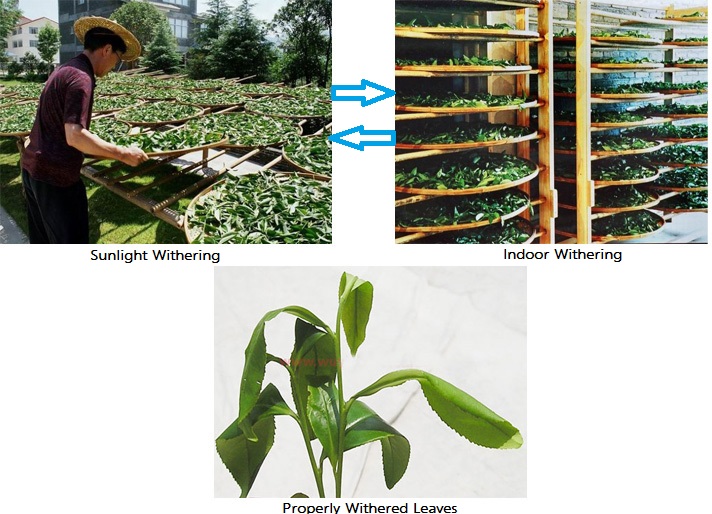
3 Make Green (做青 Zuo Qing)
After withering, it come to the most important and complicated processing of Wuyi Rock Tea, Make Green(做青Zuo Qing). This processing include three handlings, Shaking Green(摇青 Yao Qing), Put Static (静置Jing Zhi) and Hand Clapping (做手 Zuo Shou).
The withered tea leaves will be put inside bamboo plate for Shaking Green. The worker will turn around the bamboo plate and also swing the plate up and down.These movement will rub and damage the cells on the edge and surface of the tea leaves. The inner biochemical contents of the damaged tea cells are released and they will produce fermentation. (The un-damaged cells are kept intact and will not produce fermentation).The processing after Shake Green is Put Static, which is conducted to leave enough time for the fermentation. The Put Static time lasts around one or two hours. Then another round of Shake Green will do. And it is followed by another time Put Static. Generally it needs conduct six or seven times of Shake Green-Put Static recycle.
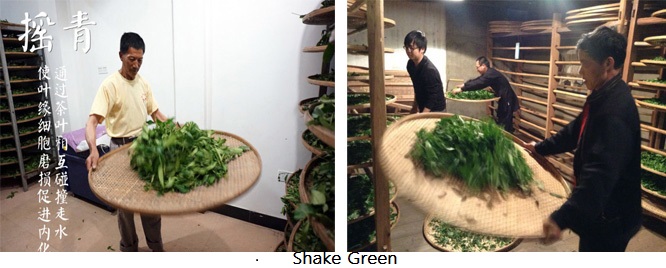
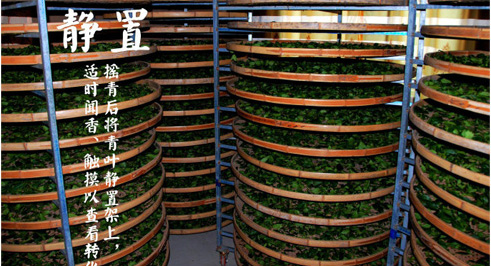
Hand Clapping is a supplementary handling for Shake Green. If the worker find that the damage of cells is not enough, he will use Hand clapping to to produce more colliding of tea leaves.
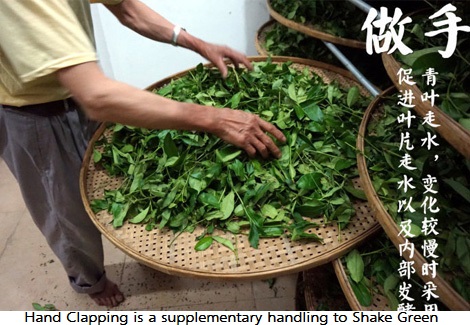
After the last round of Shake Green-Put Static handling, the tea leaves will start give off fragrant flavor. And the leaf edge turn to red color and the center of the leaf will become yellowish green.
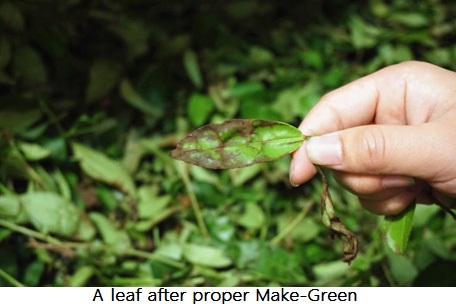
The tea makers can not sleep overnight. It is very exhausting work. They need to do all the handlings by hand and watch the change of leaves, mainly color change and flavor give-off. Furthermore, they need to judge the conditions of temperature, humidity and nature of tea leaves to decide the handling extent and timing by their experience and insight. To make a good Wuyi Rock Tea requires very high level performance of the tea makers. It’s a kind of artistic work.
4 Frying and Rolling
After Make Green, the tea is ready for frying. The traditional frying of Wuyi Rock Tea is conducted in Iron Pan. and heat up by firewood. The high temperature of frying will stop the fermentation of broken cells and deactivate the enzymes in live cells. Thus the quality formed in Make-Green is kept. After frying, the fermented part of leaf carry the nature of black tea, the un-fermented part carry the nature of green tea. This is a typical oolong tea.
Wuyi Rock Tea is Unique in that it will conduct double frying and double rolling (双炒双揉). The first time rolling is higher in temperature which is mainly served to stop the fermentation and deactivate enzymes.
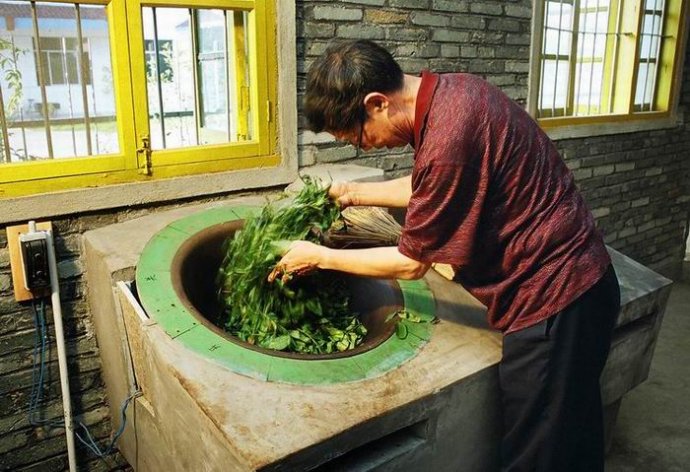
First Frying
Frying is followed by Rolling. Rolling is conducted to make the tea body. and also rolling will help release tea juice (already stabilized) from the leaves.
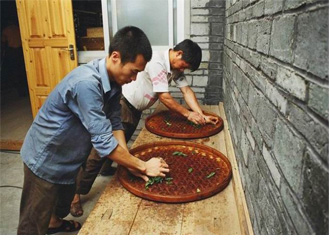
First Rolling
Then it will conduct second frying. The temperature of second frying is lower than first frying. While it will change the biochemical content of tea leaves drastically. Especially the released tea juice will produce a kind caramel flavor (cooked sugar) and boost the decomposition of pectin. Double frying is of the the critical processings to make the special characteristics of Wuyi Rock Tea.
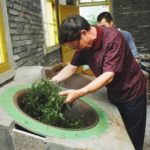
Second Frying
The second rolling will finally make the exquisitely tight body of Wuyi Rock Tea.
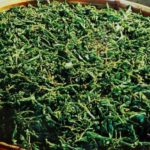
Tea after second Rolling
5 Baking
Baking is one of the other most critical and complicated processings of Wuyi Rock Tea. It include Primary Baking, Sorting and Re-baking.
Traditional baking of Wuyi Rock Tea prefer charcoal heat. Generally charcoal heat baking tea obtain better quality than nowadays electric heating. Just as we experience in cooking, natural heating produce better food than electric heating. During the baking smoke is definitely not allowed to occur.
In Primary Baking, the temperature is high at around 100-110℃. And it need stirring the tea frequently to avoid burning flavor. The processing will finish when the water loss reach 60%-70%. Over-long time Primary baking will reduce the flavor of tea. Because high temperature will cause volatilization of aromatic substances in tea.
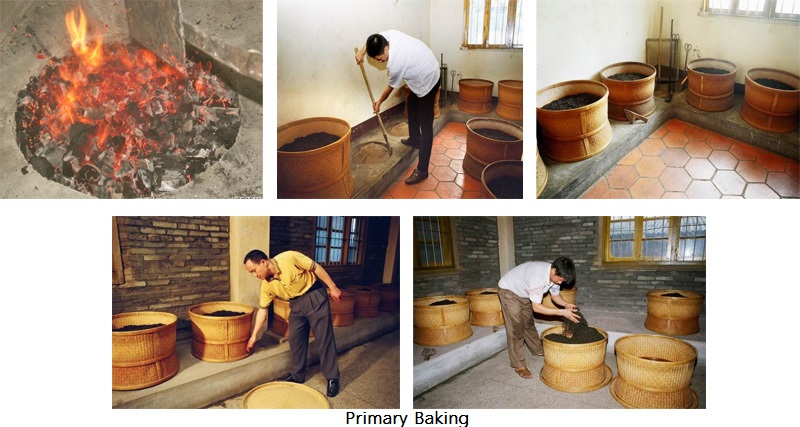
After Primary Baking, the tea will sent for Sorting. Sorting also include three handlings, Bamboo Plate Sorting, Cool Down and Hand Sorting.
The workers swing the bamboo plate up and down to remove the broken leaves and dust.
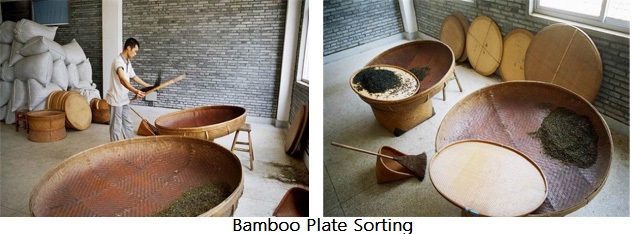
Then the sorted tea will be put on the plate to Cool Down for a few hours. During the Cool Down, the water content in the leaf will re-distribute evenly in the leaf structure which will do help for Re-baking.
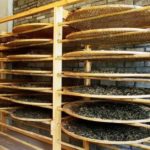
Cooling Down
After Cooling Down, Hand Sorting will be conducted to sort out yellow flats, broken leaves and foreign stuff.
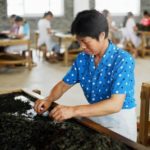
Hand Sorting
After Hand Sorting, the tea is ready for Re-baking. The temperature of Re-baking is lower than Primary Baking. And it will last longer time. The workers should monitor the temperature and make it even during the whole processing. In the end of the Re-baking the tea would give off fantastic flavor and it would turn out treasure oily dark color. Then the processing is finished.
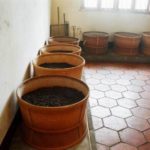
Re-baking
This is the final product Wuyi Rock Tea.
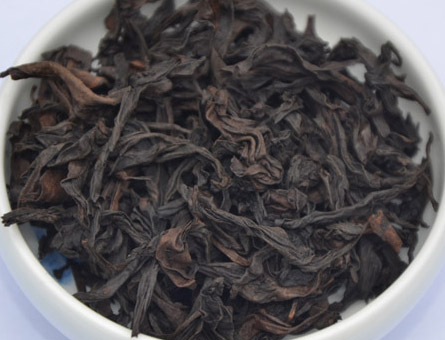
Then the tea will be put in the wooden chest for export packing. This is the image showing Wuyi Rock Tea export packing 200 years ago.
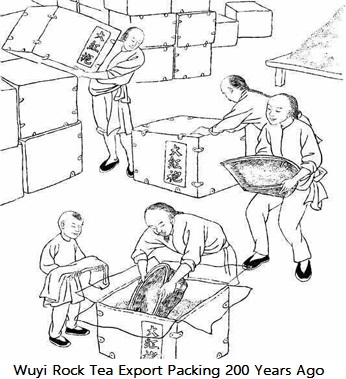
Changsha Wufeng Tea Co.,Ltd ® Copyright Reserved
Tags: Wuyi Rock Tea
Category: Uncategorized



